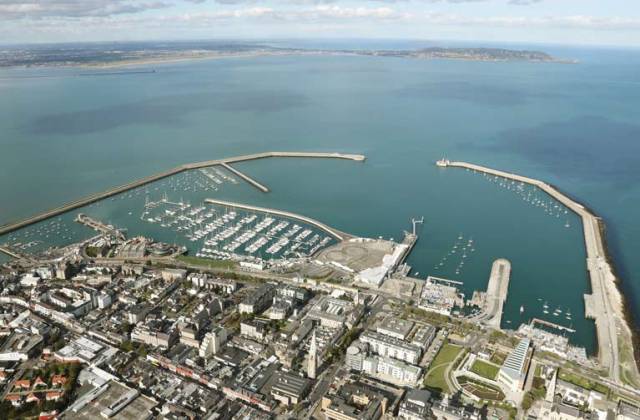The Volvo Dun Laoghaire Regatta has something for everyone at all levels of sailing writes W M Nixon. It’s an event which attracts sailors who have reached the highest levels of international competition ranging through Olympic Medalists and America’s Cup contenders to those who have proven themselves at the very sharpest sharp end of offshore racing.
Yet equally it is the ultimate suburban sailfest for 480 boats (now 500, see here - ed) and their many crews in numerous classes, bringing out the competitive spirit in amiable club sailors who may be competing on Dublin Bay within sight of their home neighbourhood, yet out on the waters of this very special bit of the sea, they become so absorbed in the racing of the day that they could be at some purpose-built venue some hundreds of miles from home.
Regattas are as much about people as boats, and the upcoming VDLR 2019 (it begins next Thursday) has certainly drawn in some noted sailors of extra interest. For instance, Eddie Warden-Owen, the CEO of the Royal Ocean Racing Club, may be best known for his central administrative role in the global offshore racing scene, and before that perhaps his greatest international achievement was in the campaigns whereby he was the guiding light in raising major Italian international campaigns to the highest level.
 The RORC’s CEO Eddie Warden-Owen will be taking part in the Volvo Dun Laoghaire Regatta 2019 in a strictly private capacity – as co-skipper of the 121-year-old Seabird Half Rater Scoter from Treardur Bay SC in Anglesey.
The RORC’s CEO Eddie Warden-Owen will be taking part in the Volvo Dun Laoghaire Regatta 2019 in a strictly private capacity – as co-skipper of the 121-year-old Seabird Half Rater Scoter from Treardur Bay SC in Anglesey.
Yet the RORC’s top administrative honcho has a family home club like many other sailors, and in the case of the Warden-Owen, it is Treardur Bay SC on the Anglesey coast in North Wales. So though the young Warden-Owen may first have emerged at national level as a GP 14 sailor of note, his family’s primary loyalty in Treardur Bay is to the 1898-founded Seabird Class of Half Raters, 20-foot semi-keelboat with centreboards which continue to provide close racing and the right class spirit at Treardur Bay and other centres.
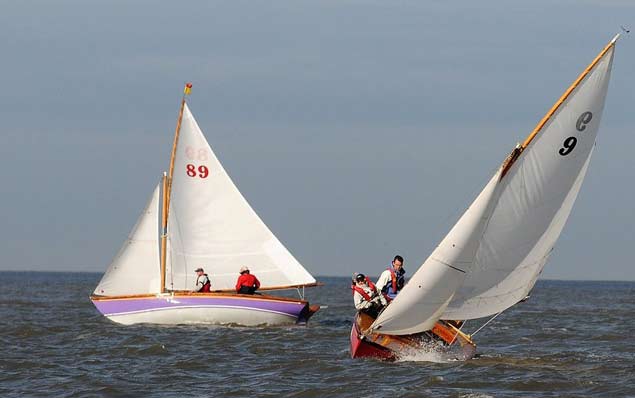 The Seabird Half Raters had their first race on June 8th 1899
The Seabird Half Raters had their first race on June 8th 1899
 The Howth 17s, seen here in a previous VDLR, had their first race on May 4th 1898. Photo: VDLR
The Howth 17s, seen here in a previous VDLR, had their first race on May 4th 1898. Photo: VDLR
North Wales has several such classes, and in recent years with improved road trailerage, they have taken the ferry to Dublin to add their own lively input to Dun Laoghaire Regatta. This time round it’s the turn of Treardur Bay to be the honoured visitors, with its members coming across with their Seabirds and also their 14ft Myth dinghy class.
The Myths are from the time of the club’s foundation around 1920, but the Seabirds go back even further, to Merseyside in 1898-99, and Eddie Warden-Owen and his brother David are custodians of the oldest boat in the visiting flotilla, the 121-year-old Scoter. Thus they will thus be vying for seniority with another classic group taking part at Dun Laoghaire, the Howth 17s from north of the bay whose design and debut afloat pre-dated the advent of the Seabirds by barely a year.
Not all the noted visiting sailors will be in unlikely alliance with boats of ancient vintage, though admittedly the RS Elite keelboats, with their design throwback to the special America’s Cup keelboats of a previous era, may still seem as modern as tomorrow to most Dublin Bay sailors.
In sailing terms, Dublin Bay is one of the most settled communities on the planet. When Dublin Bay sailors find a One Design they like, they tend to stay with it for decades, with years after year of congenial and convenient local sport in a friendly environment in the same boats, a process which is likely to be reinforced by the unexpected longevity of glassfibre craft.
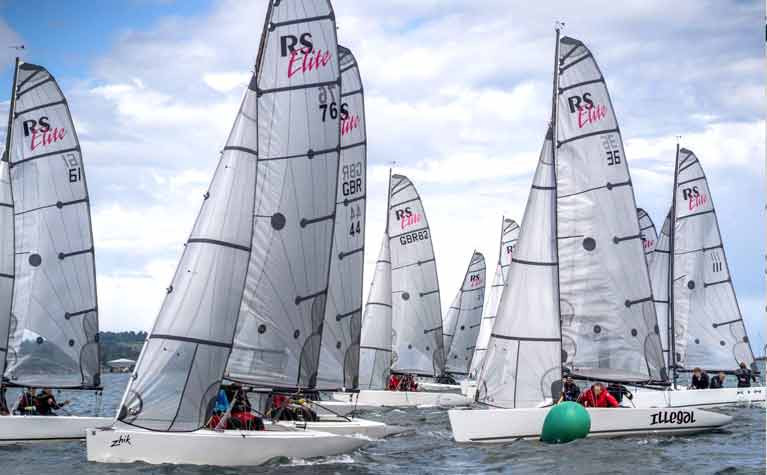 The appearance of the RS Elite is something of an acquired taste……
The appearance of the RS Elite is something of an acquired taste……
 …..but they look better when properly trimmed and going well
…..but they look better when properly trimmed and going well
So the fact that the RS Elites have chosen the VDLR 2019 to incorporate their annual National Championship is a compliment to their hosts and the spirit of the bay, and the class in turn is giving it full top-level support with its contenders including at least two former Olympic medallists – current RS Elite Champion Mike McIntyre who took Gold in the Star Class in 1988, and Ossie Stewart who got bronze in the 1992 Olympiad crewing with Lawrie Smith in the Soling, while for good measure the 34-strong RS Elite lineup also includes current International 14 World Champion Andy Partington and former International Dragon Edinburgh Cup winner Simon Brien from Cultra on Belfast Lough.
 Current RS Elite Champion is Mike McIntyre, Gold Medallist in the Star Class in the 1988 Olympics
Current RS Elite Champion is Mike McIntyre, Gold Medallist in the Star Class in the 1988 Olympics
Our own Olympic Silver Medallist Annalise Murphy is also down for racing in Dun Laoghaire with her International Moth if she can balance it with the current 49erFX campaigning. But once in Dun Laoghaire, the mood can be so relaxing that mid-regatta boat transferences are not unknown, and we might just as likely see our top sailor out on the bay with her mother Cathy McAleavey in one of the latter’s Dublin Bay Water Wags, truly a “Classic of the Classics” with the class’s origins going all the way back to 1887.
This friendly inter-change between varying classes and extremely different boat types hints at something very special in the total sailing environment to be found in the Greater Dublin area, and for locals the VDLR serves a very useful extra purpose in reminding us of just how remarkable is our local sailing.
 Cathy McAleavy racing her Water Wag in the VDLR with her daughter, Olympic Medallist Annalise Murphy. Photo: VDLR
Cathy McAleavy racing her Water Wag in the VDLR with her daughter, Olympic Medallist Annalise Murphy. Photo: VDLR
We have a handsome and vibrant river city, elegantly set in surrounding hills and mountains, and dynamically interacting with a graceful bay. It’s a bay that gives a sense of immediate access to open sea while at the same time providing sufficient sheltered water to promise the ideal location for close-fought racing among a large fleet of boats of many types, with competition at all levels of intensity.
Greater Dublin’s busy population well knows how to make the best use of the diverse sailing opportunities on its doorstep. And for its notably affluent population in the conurbation’s extensive hill-girt southern sector, virtually all of the remarkable maritime energy is focused through one sailing port, the large and classically-inspired artificial harbour of Dun Laoghaire with its four highly-individualistic and undoubtedly stylish yacht clubs, whose historic style is balanced by the most convenient of quayside facilities supported by an extensive marina.
So many factors combine in making the Volvo Dun Laoghaire Regatta the largest sailing event in Ireland that in the end whether it’s a success or an outstanding success comes down to the one element over which the organisers have no control: the weather.
 Gentle summer weather, vintage clipper bows – the distinctive stem profiles of Myfanwy (built 1897) and Peggy Bawn (built 1894) at the VDLR 2017. Photo: W M Nixon
Gentle summer weather, vintage clipper bows – the distinctive stem profiles of Myfanwy (built 1897) and Peggy Bawn (built 1894) at the VDLR 2017. Photo: W M Nixon
Last time round in 2017, summer was settled comfortably on Dun Laoghaire, with balmy almost windless evenings, yet each day brought more than enough wind to see the programme satisfactorily completed, while keeping things gentle enough such that many classes – particularly those in the classics and traditional divisions - could finish with considerable style within the harbour.
But then, 2017 marked the Bicentenary of this remarkable structure, which has been so solidly built of local granite that it now seems to be a natural part of the landscape. Nevertheless the memories and sentiments of the Bicentenary have been incorporated into the way we think about this very special regatta with its unique purpose-designed format, which only finally emerged in 2005 after several attempts over several decades to provide Dun Laoghaire with a flagship event which matched the significance of the Harbour’s role in local, national and international sailing.
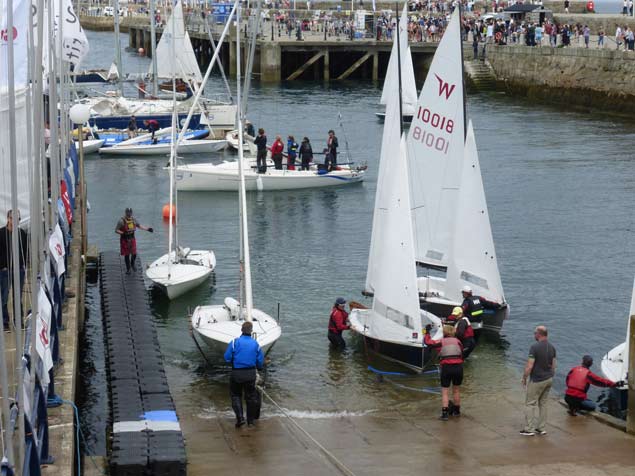 A 200-year-old harbour responds to contemporary needs – retrieval time for Flying Fifteens and Wayfarers at the National YC during the VDLR 2017. Photo: W M Nixon
A 200-year-old harbour responds to contemporary needs – retrieval time for Flying Fifteens and Wayfarers at the National YC during the VDLR 2017. Photo: W M Nixon
But while the basic programme of four days of racing beginning on Thursday afternoon and concluding with a boisterous prize-giving on the Sunday afternoon has been successfully maintained, each time round the Organising Committee incorporates lessons learned from each staging. And they add useful innovations too, for the Dublin Bay sailing setup is such that Don O’Dowd, the current Chairman, and his Organising Committee find like their predecessors that their “clients” are so passionate about the sport in their bay that they are definitely not backwards in coming forward with suggestions for their own notions of regatta improvement.
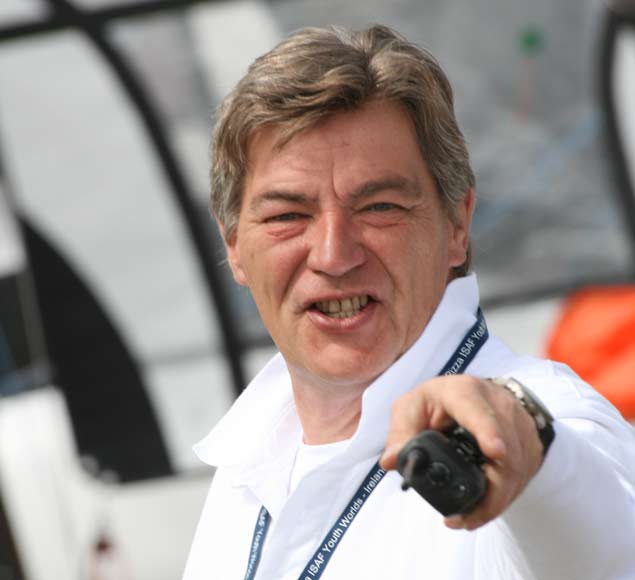 Don O’Dowd, Regatta Chairman
Don O’Dowd, Regatta Chairman
All in all, it’s an extraordinary logistical challenge, with 450 boats and at least 24 separate classes, with the actual number depending on how you define “class”. There’s everything from top-level IRC racers through a colourful variety of One Designs and on to traditional and classic boats of such vintage that it’s a brave pundit who would say just how old they are.
As for the actual sailing, it can vary from a crowded daily programme with top-standard races back-to-back, through just one gentle race for special boats, while the IRC fleet have the added option of joining a division with just one coastal race per day which better allows them to spread their wings, and for 2019’s Regatta, the coastal racers will include George Sisk’s Xp44 WOW (RIYC) fresh from victory in the coastal division at the Sovereign’s Cup in Kinsale, Dingle race winner Paul O’Higgins’ JPK 1080 Rockabill VI, former Sailor of the Year Conor Fogerty’s new foiling Benetau Figaro 3 Raw from Howth on the countdown to the Fastnet Race on August 3rd, and current ISORA Champion, the J/109 Mojito (Peter Dunlop & Vicky Cox, Pwllheli SC).
This means that Mojito will not be in face-to-face competition with the increasing Irish J/109 fleet, which reached a fresh height of competitiveness at the Sovereign’s, with the new boys on the block for 2019, Richard Colwell and Johnny Murphy’s Outrajeous, looking good for honours with Mark Mansfield – who was on the strength in the successful campaign in Kinsale – back on board for the Battle in the Bay.
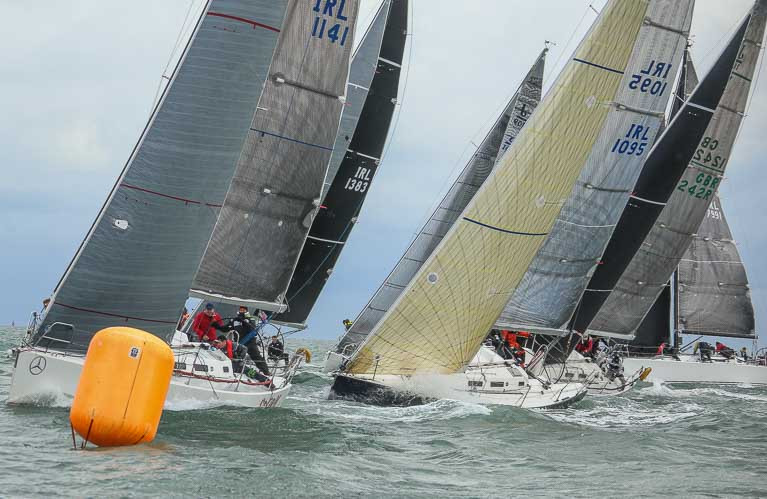 J/109s in close contention in Dublin Bay. This classic American design fits well with the Dublin Bay One Design tradition. Photo: Afloat.ie
J/109s in close contention in Dublin Bay. This classic American design fits well with the Dublin Bay One Design tradition. Photo: Afloat.ie
Not all the top J/109s were at Kinsale, and current 2019 Champion, the Goodbody family’s White Mischief (RIYC), is hotly tipped for success sailing on waters in which pater familias Tim Goodbody has achieved more major wins than anyone can remember in several different types of very competitive One Designs. Meanwhile, a former Irish champion J/109, Pat Kelly’s Storm of Howth and Rush SC, has beefed up her crew strength for Dun Laoghaire with the addition of sailmaker Nigel Young.
The J/109s in their current hyper-tuned state are more than enough for most of us to be contemplating, but a further ingredient is added to the mix with the presence of the newly re-crowned RC35 champion, the First 36.7 Animal from Scotland (Debbie Aitken), so for those with a mind to concentrate on the results of just one class, the J/109s have enough to be going on with.
But to take such an approach is not in the spirit of the regatta, and the reality is that if we go down the IRC Divisions, we happen upon the classic Half Tonners, miracles of restoration mostly based in Howth which in 2019’s hugely intense early season raised their racing bar even higher.
Currently, the pacesetter is Mata (Michael & Darren Wright and Rik De Neve, HYC), which a year ago was a somewhat tired old warrior which seemed to have her best years behind her. But the Wright team took her over and with crew boss Sam O’Byrne co-ordinating a meticulous re-birth in Alan Power’s renowned “laboratory” in Malahide, Mata was ready for the Scottish Series at the end of May where she gave her first indication of things to come as runner-up to clubmate Jonny Swann’s Harmony. Then she was in the groove in the ICRA Nationals to win, and by the time the Half Tonners were joined in really serious group battle at Kinsale, it was Mata which won the Half-Ton Nationals incorporated in the series, and for Dun Laoghaire, her crew-of-all-the-talents continues to include sailmaker Shane Hughes.
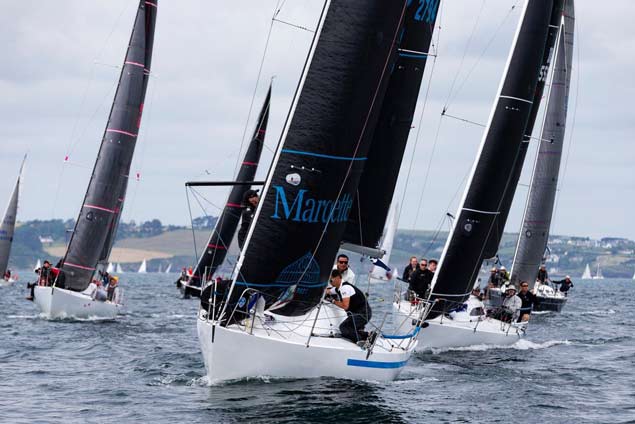 The Half Tonner Mata winning in Kinsale. Only a year ago, she was a tired old warhorse, but a major revival programme has worked wonders
The Half Tonner Mata winning in Kinsale. Only a year ago, she was a tired old warhorse, but a major revival programme has worked wonders
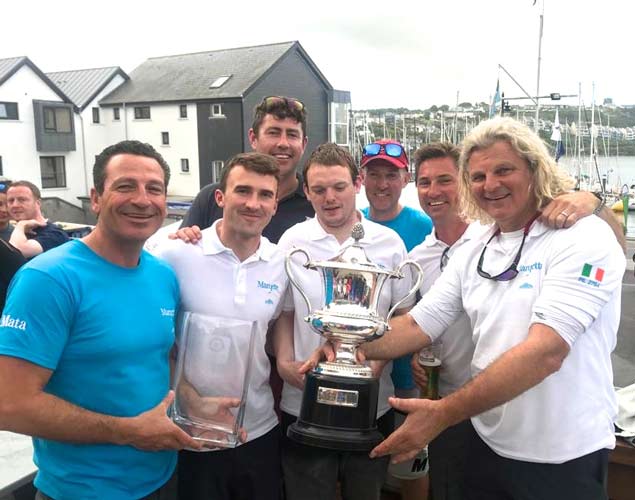 These are the boys to beat – the Mata crew in Kinsale with the Irish Half-Ton Champions trophy are (left to right) Darren Wright (helm), Sam O’Byrne (mainsheet), Killian Collins (tactics), Ciaran White, Shane Hughes of North Sails, Rick De Neve, and Michael Wright
These are the boys to beat – the Mata crew in Kinsale with the Irish Half-Ton Champions trophy are (left to right) Darren Wright (helm), Sam O’Byrne (mainsheet), Killian Collins (tactics), Ciaran White, Shane Hughes of North Sails, Rick De Neve, and Michael Wright
Inevitably the location of the sailmaking sorcerers throughout the fleet is always a useful guide to potential performance, and up in the dizzy heights of Class 0, the word is that Maurice Prof O’Connell will be back with Crosshaven’s Conor Phelan on the Ker 36 Jump Juice to see if they can topple Frank Whelan of Greystones from the remarkable dominance he showed in Kinsale to win the Sovereign’s Cup with a clean sweep of wins right down the line with the Grand Soleil 44 Eleuthera.
Another element in Class 0 is the regular and competitive presence of Jay Colville’s First 40 Forty Licks from East Down YC in Strangford Lough, while there’s a new presence to be factored in with the re-appearance of Jamie McWilliam of the Royal Hong Kong YC with his Ker Fast Forty Signal 8, and the turnout in Class 0 has another twist with the appearance of Scotland’s Jonathan Anderson with the J/122 El Gran Senor.
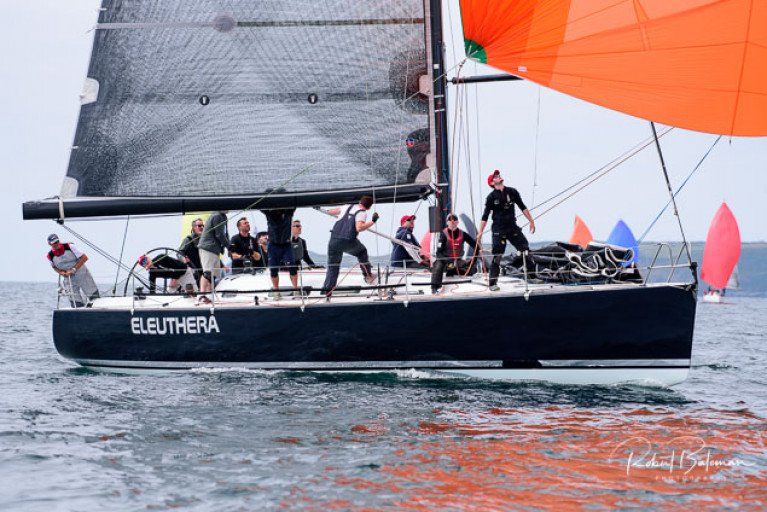 Another of the “Boats to Beat” – Frank Whelan’s Eleuthera from Greystones will arrive in Dublin Bay fresh from a clean sweep in Kinsale. Photo: Robert Bateman
Another of the “Boats to Beat” – Frank Whelan’s Eleuthera from Greystones will arrive in Dublin Bay fresh from a clean sweep in Kinsale. Photo: Robert Bateman
After considering the various rating permutations which come as part of the deal with IRC classes, it’s like a breath of fresh air to turn to the extensive One Design dinghy and keelboat presence, but even here the twenty or so classes which will be receiving their own starting signal present a bewildering variety of types, though one thing is clear – the visit of the RS Elites means that with 34 boats, they’re the most numerous keelboat OD class, toppling the Flying Fifteens with their 23 boats for 2019 from their usual dominant position, while it has to be said that the Sigma 33s, celebrating their 40th Anniversary, are putting in an excellent show with 20 boats all determined to make life difficult for current champion Rupert (Dick & Philip Lovegrove, RStGYC).
Another good turnout is the 15 boats being achieved by the J/80 Class, which has proven to be particularly suited to Irish requirements. The impact of the J/80 may be relatively new, but we cannot help but notice that one of the favoured helms in the class next week has to be Robert Dix, yet another product of the remarkable sailing nursery which is Malahide.
His continuing sailing skill prompts us to remind the Royal Cork YC that at their Quarter Millenial Celebrations in 1970, one Robert Dix at age 17 emerged as the youngest-ever winner of the Helmsman’s Championship of Ireland. With the RCYC Tricentenary coming up next year, the Golden Jubilee of Dixie’s success is surely something which will get a special mention.
With many of the One Designs - dinghies and keelboats alike - it’s national and world championships coming down the line which are shaping their thinking. The Flying Fifteens are well into the countdown for their 2019 Worlds at the National YC in September, while the GP14 Worlds are in Skerries next year, and they have their Irish nationals at that venue next month. Meanwhile, the VDLR 2019 is also their Leinster Championship, and a fleet of 34 makes them the biggest dinghy class, notable among them being new GP 14 sailor Alex Barry of Monkstown Bay on Cork Harbour, whose early successes this year point towards an interesting trajectory towards the Worlds.
 The GP 14 Munsters at Cullaun in May, when Alex Barry of Monkstown Bay and Richard Leonard made a successful debut with the class. They will be racing with a large class of GP 14s in the VDLR 2019 in what will also be the Leinster Championship. Photo: Rachel Thunder
The GP 14 Munsters at Cullaun in May, when Alex Barry of Monkstown Bay and Richard Leonard made a successful debut with the class. They will be racing with a large class of GP 14s in the VDLR 2019 in what will also be the Leinster Championship. Photo: Rachel Thunder
The introduction of a Classics & Traditional Division in the VDLR 2017 as a special for the Harbour Bicentenary worked so well two years ago that it’s a feature which has been retained, and of course if we add in the older One Designs which consider themselves race boats first and classics as a bonus, boats like the Seabirds, the Howth 17s, the Water Wags, the Mermaids and the Myths, there is actually a quite substantial Classics Regatta to be discerned within the larger picture.
There’s a substantial and varied entry in place. The huge numbers of volunteers are quietly working themselves into their vital roles. The flotilla of committee boats have been vigilantly checked for smooth functioning. And the structures – administrative and physical alike – are taking their final shape ashore. So now, with summer having firmly shown itself to be here or hereabouts – albeit somewhat unevenly - in recent weeks, what are the wind and weather prospects?
As the man said, forecasting is so difficult because it involves predicting the future…..We’re supposed to have access to reliable ten day forecasts these days, but 2019 has already shown that this is a mistaken assumption. At the time of writing, the Jetstream is to the north of us. Let us hope it stays there, yet leaves enough energy to provide a decent sailing breeze each day, but not too much…..
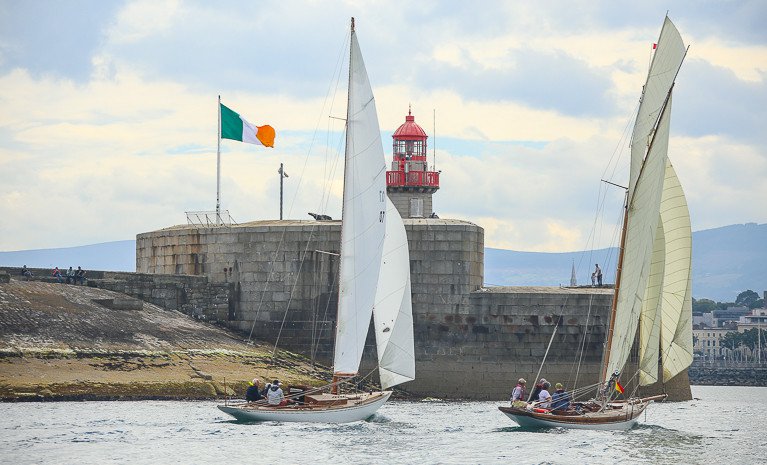 The enduring image of the Volvo Dun Laoghaire Regatta 2017 – in a warm summer breeze, the Dublin Bay 24 Periwinkle and the 1897 Alexander Richardson cutter Myfanwy race neck and neck for their in-harbour finish. Photo: Afloat.ie/David O’Brien
The enduring image of the Volvo Dun Laoghaire Regatta 2017 – in a warm summer breeze, the Dublin Bay 24 Periwinkle and the 1897 Alexander Richardson cutter Myfanwy race neck and neck for their in-harbour finish. Photo: Afloat.ie/David O’Brien



























